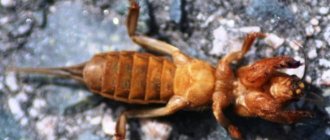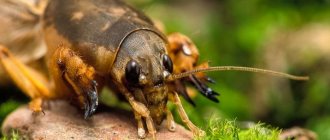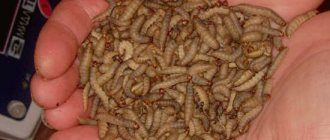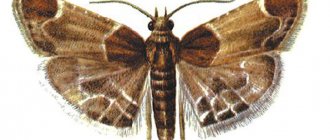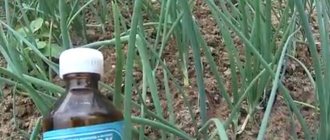The mole cricket, commonly referred to as cabbage weed or earthen crayfish, is a very large insect, reaching a length of 5 cm. It is nocturnal and prefers moist soil. When the air is warm enough, it is capable of flight and is especially active in May. While making underground passages, it gnaws at the root system of garden plantings, for which it received the title of a malicious pest. You can catch a mole cricket using homemade traps and trapping pits. Beer, honey, butter, and cereals are used as bait. The use of eggshells, repellent aromas, and planting of certain plants is also recognized as an effective method of control. All these means are applicable both in open ground and in greenhouses.
How to catch a mole cricket?
Gardeners catch insects in order to reduce their numbers, while fishermen use cabbage grass as bait for catfish and carp. There are several simple ways to catch mole crickets:
- The insect loves moist soil and especially heaps with cow manure and humus. Armed with a shovel, you should carefully turn over the layers of compost. Individuals leaving their shelters are collected and placed in a pre-prepared container.
- In the garden, it is enough to cover the beds with film or cardboard. After 2–3 days, a significant number of mole crickets will gather under the covering material. The number of “catch” depends on the speed of the catcher’s movements and reaction. Insects are very nimble and scatter quickly.
- You can lure the pest at night using a flashlight. To do this, a lighting device is suspended or installed in one area. The mole crickets will crawl towards the light; all that remains is to illuminate the crawling individuals with another flashlight and collect them.
- Another simple way to catch a mole cricket is to throw pieces of soil into the water, wait for the insect to float up and catch it with a net.
- Washing powder will help lure cabbage worms out of their burrows. If nests or underground tunnels are found, pour a solution prepared from 2 - 4 tbsp. l. any powder and 10 liters of water. The components of the mixture create a film and prevent the access of oxygen. After a few minutes, insects begin to leave their shelters en masse. To destroy them, use a shovel, literally cutting the mole cricket in half.
- An alternative to washing powder is soap solution. To prepare it, 100 g of tar or laundry soap should be crushed or grated and combined with 10 liters. water, stir until completely dissolved.
- You can also pour sunflower oil into the passages. First, add 20–50 mg of oil, then 8–10 liters of water.
It is not recommended to catch insects with your bare hands. In attempts to free themselves, mole crickets can painfully scratch the skin.
For storage, jars are used, the bottom of which is lined with wet sawdust. I use plant roots as food. It is advisable that each individual live in a separate container.
Repelling mole crickets with iodine solution
According to the observations of gardeners, the mole cricket avoids certain odors. Therefore they suggest:
- plant marigolds, calendula or chrysanthemums in the inter-rows of vegetable crops;
- place branches of coniferous trees (spruce, pine, fir) between the potato beds (after flowering);
- stick freshly cut stakes or branches of aspen or alder 2-4 cm thick (necessarily with bark) into the ground of the beds. It is recommended to stick such stakes to a depth of 25-30 cm, at a distance of 1.5-2 m from each other, and change them as they dry;
- water the “marked passages” places in the garden with an infusion of onion peels and onion waste;
- when planting seedlings, throw a clove or a little crushed garlic into the prepared hole;
- Place fresh fish in the holes for planting vegetables, which, when decomposed, will give off an intimidating odor;
- Make large furrows along the perimeter of the greenhouses, into which pour naphthalene or sand soaked in kerosene;
- When sowing seeds of parsley, beets, carrots and other root vegetables, water the furrows with water with added iodine. It is recommended to add 20 drops of iodine to 10 liters of water.
It also happens: How to catch with a crank
Each of the “fragrant” methods has its supporters and opponents - depending on the results of your own use or feedback from neighbors. Only personal experience will tell what the result will be on your site.
If traditional methods do not help, you can always use ready-made remedies, a selection of which you will find in our market. A selection of remedies for mole crickets.
Thunder (50g.) (from mole crickets, garden ants) 28 rub VIEWAgrofirm Poisk Insecticide Rubit® granular ready-made bait for protecting plants from mole crickets (100 g) 34 rub VIEWAgrofirm Poisk Medvetox (100 g.) (mole cricket, ants) 38 rub VIEW Agrofirm Poisk Grizzly (1x20 g. ) (from the bear) 16 RURVIEWAgrofirm Search
How to make a mole cricket trap from manure
For cabbage weeds, dung beetles are a favorite habitat where they feel comfortable, lay eggs, and overwinter. In most cases, contamination of the site occurs through compost. There are several options for traps with manure that allow you to get rid of mole crickets.
First way
Recommended for use in August and early autumn.
- Dig a hole at least 50 cm deep.
- Cover the bottom with plastic wrap.
- Line the bottom with a layer of manure.
- Leave the hole open.
The mole crickets will crawl into the trap in order to spend the winter. When the temperature drops to sub-zero, a hole should be dug. You can spread manure around the area. The insects will not have time to dig deep tunnels and the entire population of pests will die under the influence of frost. There may be several such traps in the garden.
Second way
Such traps are effective both in spring and autumn.
- Dig a hole 0.5 - 0.6 m deep.
- Cover with plastic.
- Fill the third part with cow dung.
- Cover the hole with planks or any hard material, leaving intervals so that the mole cricket can crawl into the hole.
- Cover with covering material to prevent rain.
- A month later, the contents are removed along with the polyethylene and burned. A new trap is being built at the same place.
Third way
This option for using manure against mole crickets can be used in open ground beds or in greenhouse structures.
- Prepare containers: bowls, plastic bottles with the neck cut off, jars, buckets.
- Bury the container so that at least 1 cm remains from the edge of the trap to the surface of the soil layer.
- Fill the containers halfway with manure. To attract pests faster, pour beer or vegetable oil on top.
- Cover the top with thick material and secure by sprinkling the edges with soil.
- After 20–30 days, remove the traps and burn them.
How to use bird droppings against cabbage weed
There are several variations of the effective use of chicken manure:
- Burrows and tunnels are filled with fresh feces.
- Dilute 200 g of fresh litter in 10 liters of water. Fill the discovered nests and underground passages with the resulting solution.
- To prevent the appearance of mole crickets in the autumn, the soil is fertilized with bird droppings.
Protecting tomatoes from mole crickets
What is all this for? Elementary - our land shelters and warms crowds of mole crickets. Numerous control methods give short-term results that do not have the best effect on the composition of the soil. But planting seedlings in the ground in plastic cups provides 95-98% protection for our tomatoes.
We will plant the seedlings in the ground together with the glass, having first completely cut off the bottom. With this method of planting, the roots are not damaged and the seedlings do not wither
Plants do not need to heal wounds and cuts; all attention is paid to adaptation to environmental conditions
We dig the soil in the hole onto the bayonet of a shovel, make a depression in the center, fill it with water and place a glass with a tomato. We place the glass in the ground using a special method - 1/3 above the ground, 2/3 underground. The mole cricket causes the greatest damage to plants in these areas. Damage to small roots is not so dangerous for the plant.
It’s worth noting that we also plant peppers in boots (pieces of hose cut lengthwise on one side) or last year’s tomato glasses. – in wide boots made from plastic bottles (3 pieces are obtained from one 1.5-liter bottle). We don’t feel any losses, we don’t give up, we don’t spend money on poison. Over the years, it seems to me, the mole crickets have become smaller due to hunger. Although it takes much more time to plant.
The mole cricket, or as it is also called the cabbage mole cricket, translated from English as “mole cricket,” is an insect whose length reaches 5-7 cm. The habitat of the mole cricket is underground. Thanks to its powerful shell, the mole cricket can hide its head a little. Adults have wings that allow them to fly up to 6 meters.
Having powerful jaws, the pest is able to gnaw everything that comes in its way - roots, plant stems, tomatoes, cucumbers, potatoes; even onions attract the mole cricket. The kapustyanka leads an active lifestyle only at night; it is almost impossible to see it during the day.
If you find traces of a mole cricket’s activity on your property, then it’s worth studying the means of combating mole crickets in your garden. This is not to say that fighting a mole cricket is a simple matter, but it is still possible to get rid of the pest.
Usually the mole cricket causes damage to a large number of plants not only by eating them, but also by simply building tunnels, as well as arranging nests. The pest damages the root system, which leads to weakening or death.
The mole cricket can move not only in the usual way, but also by small flights or jumps. At night, it makes characteristic trills, which is what you can use when fighting insects. For example, at night, when pests crawl out of their holes, walk around the area, determine the location of the holes by sound and mark them with pegs, and begin extermination during the day.
The female mole cricket is considered to be very fertile; the larvae hatched from eggs at first look more like small spiders, and with age, turning into an adult. The mole cricket can remain in the larval state for up to several years.
The pest does not always feed on plants, sometimes displaying the habits of a predator. In turn, the mole cricket is happily eaten by some garden dwellers, for example, snakes, hedgehogs or large birds. For those who managed to lure these animals to the site, the problem with the mole cricket may be, if not completely solved, then the number of pests will certainly decrease.
Beer trap
According to farmers, the best bait for mole crickets is beer. With its help you can catch up to 15 individuals in one device. To make a beer trap you will need:
- 0.5 liters of cheap beer;
- 6 wide-neck plastic bottles, 0.5 l;
- 6 small pieces (30x30 cm) of plywood or linoleum to cover the hole;
- 6 pieces of dense linoleum 6x6 cm - backing for the bottle neck.
How to make a trap:
- Pour beer into 6 bottles.
- In places where mole crickets, their burrows or tunnels have been spotted, loosen and moisten the soil to a depth of 15–20 cm.
- Make holes in the prepared soil with a diameter of about 20 cm and a depth of 5–6 cm.
- Place beer bottles in the centers of the holes at an angle of 45°, making sure that the neck of the tilted container does not extend beyond the hole.
- Place a small piece of linoleum under the neck of each so that the insect can crawl into the trap without obstacles and not cover it with soil. If this is not available, wood chips and plywood are used.
- Cover the hole with the trap with any light-proof material: roofing felt, plywood, linoleum, tin.
- Cover the edges with soil. This will maintain moisture and twilight.
There is no need to monitor the contents of traps daily. It is enough to check them once a week. The caught individuals are burned, fresh beer is poured into bottles and installed in new places.
Soapy water
The places where the mole cricket lives are easy to find. If you walk along the beds or along paths around damp areas of the garden, you can see small loosening of light earth on the side warmed by the sun. Quite often a mole cricket nest is located here. By checking with your finger, you can detect its passages and a hole going down. All that remains is to pour out the mole cricket hidden here using oil and water.
The mole cricket becomes active on freshly watered soil or after a good rain. When I water the garden and see a lot of mole cricket moves, or find plants eaten by it, I carefully examine the moves and feel for the hole with my finger. Having found it, I widen the passage with my finger and pour oil into it, pour in water. If the mole cricket is here, then it is doomed.
From mid-May, mole crickets begin to build nests in the soil. At this time we find them while weeding the beds. The mole cricket's nest is compacted soil in the form of a hollow ball, inside which it lays eggs.
When you discover a mole cricket nest, you need to be careful and not rush. Near a compaction found in the soil, I use my index finger along its burrow to look for a downward path. I remove the excess soil, use the same finger to make a small funnel and pour sunflower oil into it. First, I pour a little water into the hole to make sure that it is really a mole cricket hole.
From a plastic bottle with a hole in the lid (1.5-2 mm), I drip 7-10 drops of oil and pour water into the hole using a ladle with a narrow spout. Sometimes you have to pour near a bucket if the ground is dry and the hole is deep.
The surface of the mole cricket’s body is covered with fine and thick “hair”. Water does not wet it, but oil does, closing the breathing holes. And then the mole cricket, as a rule, comes to the surface. If the oil wets the mole cricket’s body sufficiently, then after a minute or two it dies. When a mole cricket is slightly oiled, it can then crawl away; here it needs to be pinned down. Such a mole cricket can also be dried, but only freshly caught.
It also happens: How to make sprats at home, recipes from: sprat, sprat, herring || How to catch sprats
When sowing seeds of carrots, beets, parsnips and other root vegetables, in order to reduce crop losses from mole crickets, last year I tried watering the rows with iodine solution (15 drops per bucket of water).
Apparently the mole cricket does not like the smell of iodine, so there were practically no passages in the beds watered with this solution.
One of the simplest and easiest methods to use. When you see the entrance to Medvedkin’s underground kingdom, prepare a soap solution and add it in a small stream directly into the hole! Just 1-2 liters of water and the insect jumps out of the hole. All that remains is to catch and neutralize it.
Special opinion Many sources advise making “any” soap solution, even from washing powder. I will risk not supporting these tips. Washing powders contain phosphates, optical brighteners, synthetic fragrances and many other additives that have absolutely no business in the soil of our gardens!
You can wait for the mole cricket to come out of the hole on its own following the smell of the bait, or you can help her decide on her own.
Prepare a soap solution. Add any soap product to a bucket of water - powder, soap, washing gel, etc. Find mole cricket holes and pour water into them.
Sensing danger, mole crickets will crawl out of the emergency entrance to the surface. At this moment, you should chop them with a shovel, breaking the body into 2 parts. Insects that did not have time to escape emerge from their holes along with the water, already dead.
Trap with honey or vegetable oil
Made from a bottle or a jar.
- The walls on the inside are lubricated with honey, so it is more convenient to use containers with a wide neck.
- The prepared jars are dug into the ground, similar to the previous method, covered with dense material and insulated with straw. Cabbage girls who are not averse to eating sweets will not pass by such a treat. But they will no longer be able to get out of the container.
If the number of pests is small, traps are checked every 7–10 days. If there are a lot of mole crickets on the site, then an inspection is carried out every 2 days.
You can put containers with sunflower oil in the same way. The effect is similar to beer and honey.
On a note! The most effective trap for a mole cricket with honey is in the autumn. During this period, insects are preparing for winter and need increased nutrition.
Industrial products
If after 2-3 years the mole cricket has not left the garden, then you should turn to industrial means. This method of exposure has serious consequences: such chemistry is quite aggressive and, if used incorrectly, can cause serious harm to both humans and their pets.
Pets are not averse to eating caught mole crickets. If you have free-roaming birds or cats and dogs on your farm, you should limit their contact with poisoned insects. All anti-pest drugs contain poisons, a good half of which are fatal to pets.
Many industrial products are universal and, in addition to mole crickets, help get rid of other annoying pests, such as ants or beetle larvae (click beetles, May beetles, etc.). Among others, farmers strongly advise and speak especially warmly about the following drugs.
Medvetox
This is a granular product with the active substance diazinon. The drug does not cause any significant harm to crops, and also does not upset the balance of minerals in the soil microflora. The product is scattered between the beds to a depth of 5 cm. The active substance begins to work after 4-5 hours. One treatment is enough for about a couple of weeks. If necessary, repeat the procedure after a month.
Antimedvedka
The granulated product is placed in the soil along with planting vegetable crops. The drug is practically not washed out by moisture, so you can easily water the beds and not worry about precipitation. The active substance, imidacloprid, is quite toxic to pets, so it must be used with extreme caution. One sachet of product is enough for about 10-15 acres.
Catching mole crickets using cereals
This trap is very easy to make with your own hands. It shows the greatest effectiveness in spring, warm times.
- Cook any of the cereals until half cooked: pearl barley, millet, rice or peas. To enhance the effect, you can add boric acid or an insecticidal preparation. To make the product attractive by smell, add unrefined vegetable oil to it.
- Dig small holes and moisten.
- Place a handful of prepared bait in each.
- Cover with plywood and linoleum. Sprinkle the edges with earth to secure. Such measures will help retain moisture and keep out sunlight.
- In the morning, the covering material is removed and the caught individuals are collected.
Bait
We begin to fight pests in the spring, when the mole cricket begins its move, i.e. by warmth. In May and early June, as soon as it gets dark, in the evening you can often hear the trills of mole crickets, similar to the songs of a cricket. At this time, mole crickets call partners for mating and prepare the nest. We notice this place, and during the day we discover the ground loosened by mole crickets and their passages.
To fight mole crickets using this method, we take pieces of linoleum, a dark film measuring approximately 30x40 cm. We make slightly smaller holes in the ground.
It also happens: Fishing with a feeder for beginners - arrangement of gear and rigging, bait and lures
We choose a sunny place for catching mole crickets in the garden, with treated soft soil - where the likelihood of this pest appearing is greatest. By the presence of passages one can judge the presence of a mole cricket.
We prepare a fragrant bait, which can be porridge (preferably rice or pearl barley), lightly greased with fresh unrefined oil for the smell.
We moisten the prepared holes with water, then place the bait in them (about one tablespoon of oiled porridge) and cover the holes with linoleum. Then we sprinkle the edges of the linoleum with soil so that light does not get under it and the moistened soil in the holes does not dry out.
Around 10-11 am we quietly approach the holes and suddenly open the linoleum. When catching mole crickets, you need to do everything quietly and quickly. If you make noise and hesitate, the mole cricket may have time to hide, and then the hole will be empty. In the hole, the mole cricket sometimes makes vertical burrows. When it is not on the surface, but there are vertical passages, then I pour it out with water and sunflower oil (see below for more on this).
The mole cricket goes into the holes to smell the oily porridge and warm up. After all, the earth cools down during the night, and under the thin linoleum the hole is quickly warmed up by the sun, which is well detected by the sensitive mole cricket. Here we catch it, squeezing the chest part tightly, and put it in a jar. She is tenacious and will move for a long time.
We dry the caught mole crickets on a warm stove or in the oven (drying in the sun is also possible, but you need to cover them from flies so that they don’t lay eggs). Dried mole cricket is an environmentally friendly and effective medicine for the treatment of serious illnesses, including tuberculosis.
If necessary, strips of linoleum for catching mole crickets can also be laid on garden paths, with or without porridge in the holes.
Bait for mole crickets The trap will not work or will be ineffective if the bait is not offered to your taste.
Smell requirements
The contents should be fragrant. To enhance the smell of any prepared product, you need to add a few tablespoons of vegetable oil. Other scents may repel insects.
Beer bait
The best remedy for mole crickets is beer. There is no need to buy expensive drinks; pests will not appreciate this gesture. You can get by with the cheapest option. 50 ml is poured into trap bottles, this is enough for insects to smell the smell. Or simply bury a beer bottle with drops of the drink left in the ground as a trap.
Porridge for bears
The bait is made from cereals. Prepare crumbly porridge. Cook until half cooked, cover with a lid, wrap in a towel. Place in small handfuls in a trap. Rice, millet, barley, peas are suitable. To enhance the effect, a poisonous agent is added to the porridge. The simplest option is boric acid. The substance is tasteless and odorless and will do nothing to repel the mole cricket. But it will begin to act when it enters the stomach.
How to catch a mole cricket with a bucket
Another accessible way to lure out a mole cricket yourself. It is used in May and June, when cabbage mushrooms become active, are absorbed in mating games and their years are observed.
- A wide bucket with a soap solution is installed on the site.
- A bright lantern is placed above the bucket.
Attracted by the bright light, individuals hit the lighting fixture and fall into soapy water, from which they can no longer get out. Judging by the reviews, during the peak season it is possible to collect half a bucket of mole crickets in one night.
Eggshell
Traps with eggshells are good at saving garden plantings from mole cricket invasions.
- Grind the eggshells and sprinkle them with sunflower oil. You can add cereal, cooked until half cooked.
- Place bait in the ground.
- After eating the bait, the insects' digestive system is injured and they die.
On a note! An easier way to use eggshells involves burying the crushed product in the soil. Constantly bumping into sharp objects, mole crickets will look for other habitats.
Summary
Mole cricket traps help to significantly reduce the population size, but they are not able to completely rid an area of pests. For effective control, comprehensive measures are used: the roots of plants are treated with insecticidal preparations before planting, and the soil is loosened and dug up in a timely manner. To deter them, chrysanthemums and marigolds are planted, aspen stakes are installed, and the soil is mulched with pine needles. To prevent mole crickets from entering the greenhouse, deep furrows are made along the perimeter of the structure, sprinkled with sand and sprayed with kerosene.
